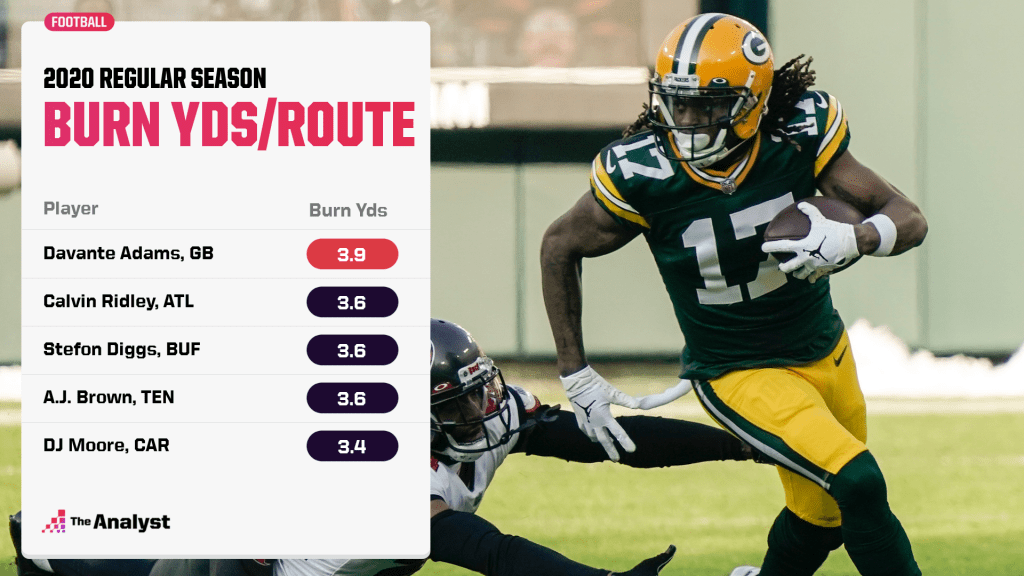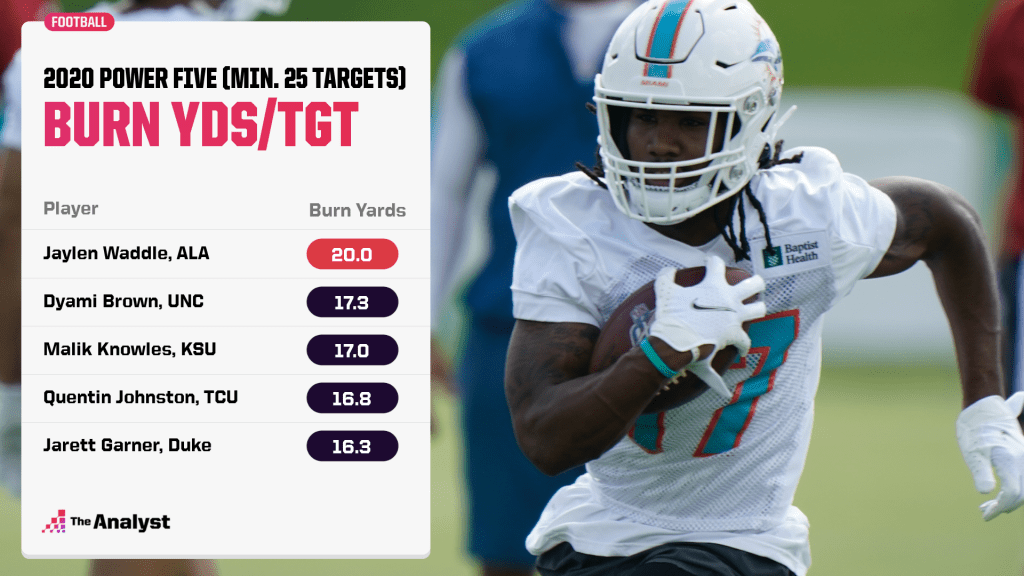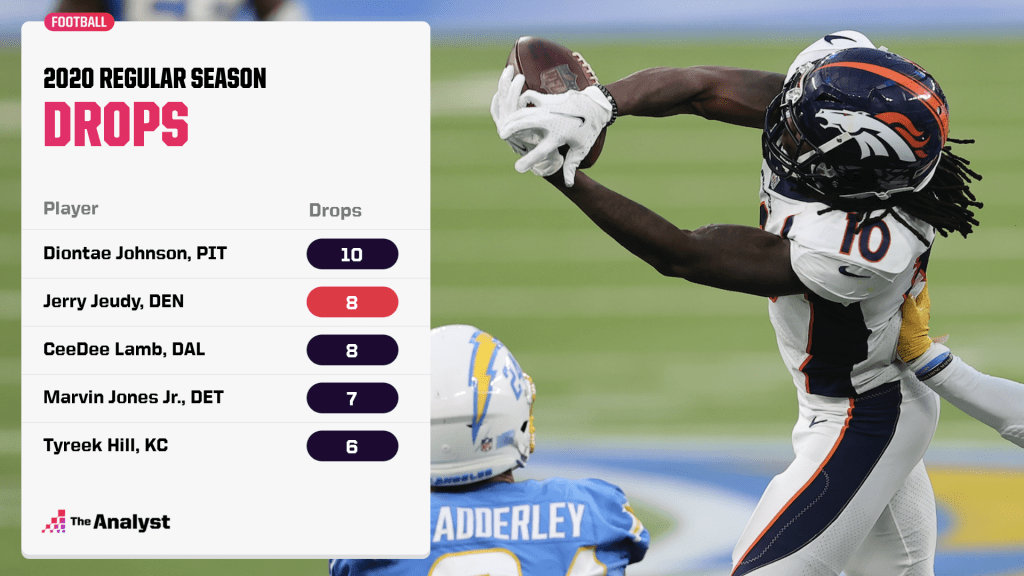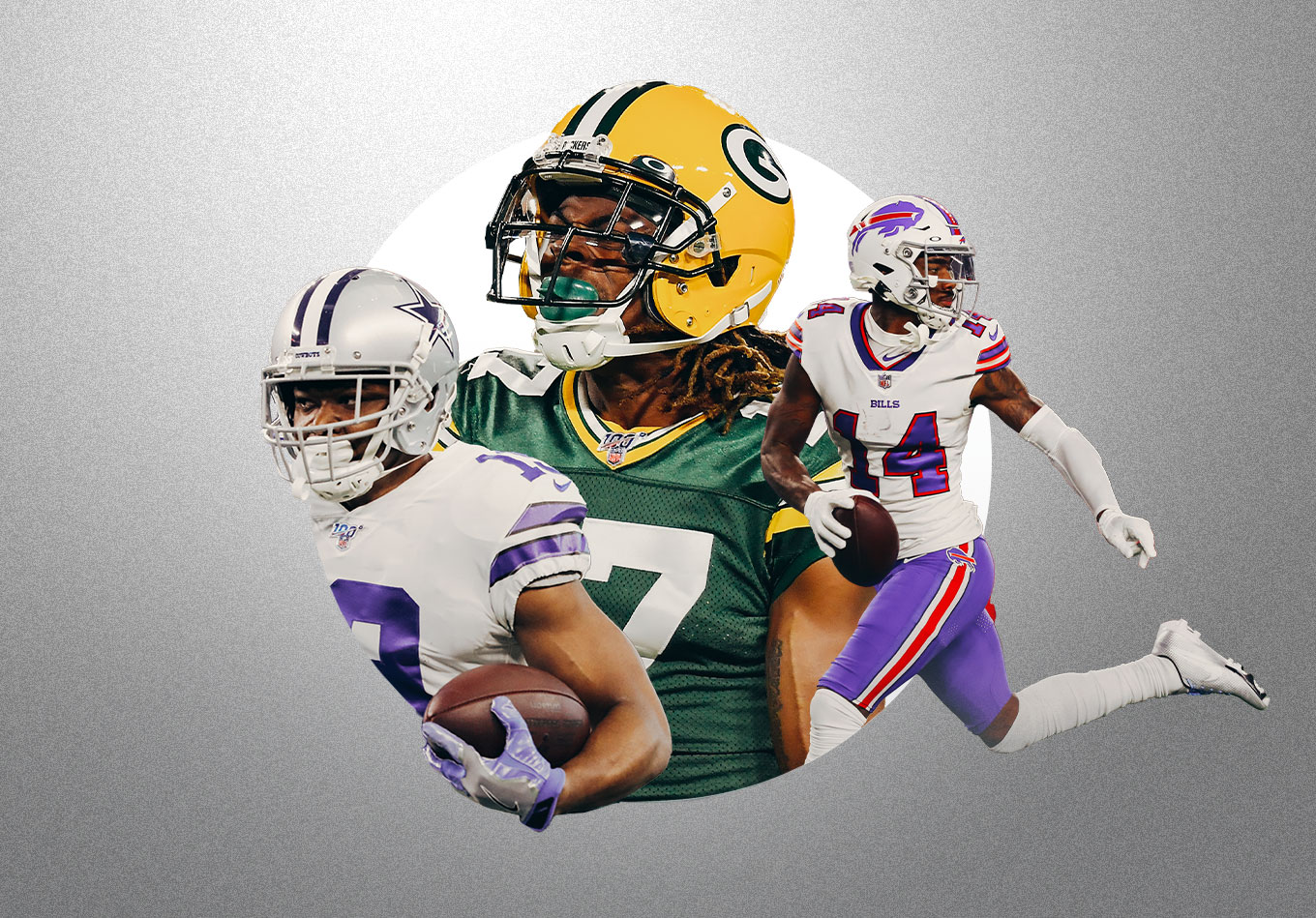It has arguably never been easier to be a pass-catcher in the NFL.
Living in a golden era of quarterback play with a host of phenomenal athletes entering the league and confounding defenses with what they can do with both their arms and legs, receivers and tight ends continually benefit from sharing the field with signal-callers who can extend the play and complete tight-window throws with outstanding ball placement almost at will.
But the best supporting casts can elevate those quarterbacks to even greater heights while those passers who lack elite talent around them at receiver and tight end can struggle to fulfill their potential as a result.
Which pass-catching groups should provide the most assistance to their quarterbacks in 2021? And which will leave the man under center poorly equipped to succeed?
We’ve ranked every group of wideouts and tight ends in the NFL by its collective open percentage from 2020, providing an insight into the best and worst pass-catching units in the league going into the new campaign.
The Elite
1. Green Bay Packers
Green Bay will have Aaron Rodgers calling the signals for at least one more year, and the reigning MVP will have the benefit of the best supporting cast of pass-catchers in football. The group combined to record an open percentage of 36.0 in 2020.
The player who did the most to inflate that number is undoubtedly Davante Adams. Arguably the best wide receiver in the NFL, Adams’ adjusted open percentage – which looks at how often a player got open against a defender’s coverage, adjusted for position – of 52.0 was second only to Julian Edelman’s 52.1.
Adams registered a burn, which is when a receiver wins his matchup on a play where he is targeted, regardless of whether the pass is catchable, on just over 70.0% of his targets, and his burn yards per route average of 3.9 was the best among wideouts last season.

Though Adams did the heavy lifting, there were signs of improvement from the players behind him on the depth chart. Allen Lazard led all receivers with a burn percentage of 82.6 and was 10th in adjusted open percentage (46.6) in 2020.
Marquez Valdes-Scantling (23.3) was less impressive in the latter regard but was second in burn yards per target (19.0). Only one team, the Buffalo Bills, got a larger contribution to their collective open percentage from their wideouts, though the Packers were 12th in terms of tight end production, indicating room for improvement at that spot even after a year in which Robert Tonyan averaged 11.7 burn yards per target.
2. Buffalo Bills
The Bills finished below the Packers in the rankings with an open percentage of 34.5 because of the lack of contribution from the tight end position, which was the eighth lowest in the league.
Dawson Knox has yet to truly harness the athletic upside that helped convince the Bills to draft him in 2019. His adjusted open percentage of 27.9 was mediocre but there was encouragement in his burn yards per target average of 10.5 that was 11th among tight ends with at least 25 targets.
Though the Bills might not be convinced by what they have at tight end, few teams in the NFL can claim to have the same level of depth at wide receiver.
The Bills have three receivers on their depth chart who were in the top 25 in adjusted open percentage last year – Cole Beasley (48.3), Stefon Diggs (42.7) and Emmanuel Sanders (41.2). Gabriel Davis also produced an extremely promising rookie year and finished 17th in burn yards per target (13.5), giving Josh Allen a plethora of options with which to try to sustain his year-three leap.
Diggs, who expediently built a tremendous rapport with Allen following last year’s trade from the Minnesota Vikings, is the cream of the crop. He trailed only Adams in burn yards per route in 2020 with an average of 3.6.
With the benefit of a full offseason to further their understanding, that Allen to Diggs connection could yet be more devastating in 2021. And, when teams do succeed in keeping Diggs under wraps, chances are another of this group of skilled separators will be able to create the space to keep a high-powered passing game operating at a level that was critical to the Bills joining the AFC’s elite.
3. Dallas Cowboys
When Dak Prescott was healthy last season, the Cowboys offense performed at a record-setting pace, which is perhaps no surprise given the wealth of options they have among their pass-catchers.
Through the first four weeks of the 2020 campaign, before Prescott suffered his season-ending ankle injury, the Cowboys led the league with 407.8 net passing yards per game. The closest team to them, the Bills, averaged 316.3 across the same period.
Whether that pace would have been sustainable even with Prescott under center is debatable, yet there is no doubt he has the weapons for this attack to be extremely potent again in 2021.
The Cowboys’ pass-catchers ranked third overall with a collective open percentage of 31.7. Amari Cooper was a significant factor in their success, finishing fourth in the NFL with an adjusted open percentage of 49.6.
Cooper recorded a second successive 1,000-yard season but tallied 12.1 yards per reception after racking up 15.1 per catch in 2019. His burn yards per route rate of 2.3 fell from 3.0 in 2019 and was at the league average for wideouts last year. Though that may be reflective of the drop-off from Prescott to Andy Dalton, Cooper will surely want to do more with the separation he can create in 2021.
Encouragingly, last year’s first-round pick Ceedee Lamb (2.5) outperformed Cooper in burn yards per route despite Prescott’s absence and there is reason to believe Michael Gallup can bounce back from a down season in which his adjusted open percentage was still a highly respectable 33.5.
Only 12 teams got less of a contribution to their overall open percentage from the tight end position than the Cowboys. It certainly didn’t help that Blake Jarwin’s season was lost due to injury. If Jarwin can stay healthy and boost the production from a spot where the Cowboys have long since struggled and Lamb can make the leap many expect, Dallas’ pass-catching corps could lay the foundation for a postseason return.
The Bottom
30. Miami Dolphins
The Dolphins are hopeful Tua Tagovailoa can put an uneven rookie year behind him, but questions must be asked as to whether they have put enough around him at the pass-catching positions to allow him to make the necessary strides.
Indeed, Miami’s group of pass-catchers goes into 2021 ranked third worst in the NFL with a collective open percentage of 25.2.
Will Fuller leads the way with an adjusted open percentage of 38.3, however, he’s suspended for the first game of the season and his injury track record makes the Dolphins’ bet on him a very risky one.
Fuller was eighth among receivers with at least 25 targets with 14.1 burn yards per target, but the Dolphins will obviously need more than an oft-injured burner for their passing game to succeed.
The Dolphins recognized that fact and made a move to address the situation by drafting speedster Jaylen Waddle, who boasts a rapport with Tagovailoa from his Alabama days. A broken ankle limited Waddle to 32 targets in 2020, but he led the Power Five with an average of 20.0 burn yards per target and was third in burn yards per route (5.6) among receivers with at least 25 targets.

The 2019 season saw Waddle finish seventh in burn yards per target (16.6) on 40 targets for the Crimson Tide, yet his arrival does not lessen the pressure on DeVante Parker.
Parker finished 2020 with only 793 yards after topping 1,200 in 2019. He also posted an adjusted open percentage of only 27.1 and had 9.5 burn yards per target rate – well below the league average of 11.0.
The Dolphins are relying on a bounce-back year from Parker, an instant impact from Waddle and consistency from a player in Fuller whose injury history has kept him from producing it to this point in his career.
Beyond that, Miami could use a significantly greater contribution from their tight ends. Mike Gesicki’s adjusted open percentage of 23.7 in 2020 was a big reason why only 10 teams ranked lower than the Dolphins in terms of contribution from the position.
That is a lot to ask of one group of players and the reality is the Dolphins might have to look to another position group to help them take the next step towards playoff contention.
31. Chicago Bears
The Bears seemingly won’t be throwing Justin Fields straight into the fire as a rookie, and part of that decision may be influenced by the lack of receiving talent around him, which is reflected by an overall open percentage of 25.1.
Regardless of whether it is Andy Dalton or Fields throwing the ball, they will likely be farming most of their passes in the direction of two receivers.
Allen Robinson (34.3) is the sole Bears pass-catcher who had an adjusted open percentage of over 30.0 last year, though Darnell Mooney (27.8) was not far off. Robinson’s 2.5 burn yards per route put him slightly above average but the Bears did not add the support to suggest he could join the elite in that category this season.
Damiere Byrd averaged 11.8 burn yards per target in his sole season in New England before signing with the Bears but is unlikely to strike fear into defenses and it’s tough to envision that rookie sixth-round pick Dazz Newsome will make a substantial impact despite his open percentage of 87.1 in his final college season at North Carolina.
With the Bears 15th in the league in contribution from tight ends, the onus will be on 2020 second-round pick Cole Kmet to take more of the burden from 34-year-old Jimmy Graham.
Kmet can look to build on a rookie season in which he ranked 12th among tight ends with a minimum of 25 targets with a burn percentage of 68.2. His ability to repay the faith of Ryan Pace and Matt Nagy may go some way to potentially saving their jobs.
32. Jacksonville Jaguars
Only one rookie quarterback has a worse situation than Fields in terms of supporting pass-catchers, and it is the man who heard his name called first in the 2021 NFL Draft.
Trevor Lawrence will get to work with a group of pass-catchers with a combined open percentage of 24.7 and only two teams were worse in terms of tight end contribution to that collective grade.
Collin Johnson (30.5) and D.J. Chark (30.3) are the only pass-catchers on the roster with adjusted open percentages of over 30.0 from last year, the former providing some reason for optimism courtesy of his above-average burn yards per target rate of 11.3.
Johnson built a decent argument for receiving more than the 31 targets thrown his way last season, yet he may still find himself near the bottom of the pecking order.
More will be expected from 2020 second-round pick Laviska Shenault after he produced a burn on only 53.2% of his targets despite an average depth of target of 6.5 yards, but he and Johnson may be prevented from making strides if Marvin Jones earns an established role in the offense.
Though Jones fell 22 yards shy of a 1,000-yard season for the Lions last year, he posted an adjusted open percentage of 25.1 and averaged 2.2 burn yards per route. Is he a player who can help this group progress or, at this stage in his career, is the 31-year-old a progress stopper?
The hope will be that Jones’ familiarity with offensive coordinator Darrell Bevell can help him provide a valuable veteran safety net for Lawrence, whose immediate success hinges on Urban Meyer’s untested ability to develop a quarterback at the pro level and the rest of the Jags’ pass-catchers making a jump that recent history indicates should not be expected.
On The Rise
22. Denver Broncos
So much in Denver hinges on who prevails in the quarterback competition between Drew Lock and Teddy Bridgewater. The early reports from training camp suggest the scales may be tipping in the latter’s direction and Bridgewater will have one of the most exciting groups of pass-catchers in the league to work with should he indeed win the battle.
The Broncos’ lowly position of 22nd in overall open percentage was likely in part a product of being robbed of Courtland Sutton for most of the 2020 campaign due to a torn ACL. With Sutton on the sideline, Jerry Jeudy produced a rookie season to suggest he can be a star for the Broncos for years to come as he led the team with an adjusted open percentage of 38.2.
Renowned for his route-running ability, Jeudy averaged 2.6 burn yards per route and 11.4 burn yards per target with an average depth of target of 14.6 (indicating he consistently won matchups on downfield routes). However, he’s hoping to reduce the drops after letting eight passes slip through his fingers.

The return of Sutton should divert coverage away from Jeudy and the Broncos also have other options who can command the attention of defenses.
Tim Patrick (32.7) was second on the team behind Jeudy in adjusted open percentage but led Broncos receivers by producing a big play on 33.8% of his targets. Noah Fant was ninth among tight ends with 50 or more targets in burn yards per target (9.9) and he and Albert Okwuegbunam have a convincing argument for being the league’s most athletic duo at the position.
In a division containing Patrick Mahomes, Justin Herbert and Derek Carr, the Broncos look desperately short at quarterback. However, if Sutton is back to his best coming off the injury and the tight ends further capitalize on their physical gifts, the Broncos may end 2021 with the top pass-catching group in the AFC West.
25. Washington Football Team
Despite extremely pedestrian quarterback play throughout the season that limited the upside of a talented receiving corps, Washington made the playoffs in 2020 despite a losing record, highlighting the lack of quality in the NFC East.
Washington’s pass-catchers go into the new season with only seven teams below them in collective open percentage (27.8), but there is reason to believe it should make significant progress this campaign.
In 2021, Washington might get unpredictability at quarterback, however, there is likely to be little pedestrian about the passing game if free-agent signing Ryan Fitzpatrick takes the reins. He produced a well-thrown ball on nearly 80.0% of his passes in 2020, though his pickable pass percentage of 6.8 was the third highest in the NFL.
Steven Sims Jr. was Washington’s best performer in terms of adjusted open percentage (41.4), though Terry McLaurin (37.2) is undoubtedly the premier receiving option. McLaurin’s burn yards per route dropped from 3.4 in 2019 to 2.9 in 2020, but he still outperformed the likes of DK Metcalf (2.8) and Chris Godwin (2.7) in a year where he registered his first 1,000-yard campaign.
With improved, if volatile, quarterback play and more dynamic options around him, McLaurin will have expectations of performing at a more efficient level this season.
Curtis Samuel can stretch defenses horizontally with what he can do out of the backfield and in the motion game, while rookie Dyami Brown offers a substantial deep threat whose burn yards per target average of 17.3 was second behind Waddle among Power Five receivers last season.
The presence of that duo will theoretically make life much easier for McLaurin and allow the pass-catchers to help this offense provide much better support to Washington’s elite defense.
A greater impact from the tight end position would aid that cause. Logan Thomas, recently signed to an extension, finished 2020 with an adjusted open percentage of only 19.7, making Washington’s presence in the bottom five in tight end contribution unsurprising.
16. San Francisco 49ers
As is the case for essentially the entirety of the Niners’ roster, the performance of their pass-catchers in 2021 is a question of health. San Francisco may not have overly impressive depth at wideout or tight end but, when healthy, it arguably boasts one of the most exciting receiving trios in the NFL.
The Niners’ pass-catchers rank 16th in collective open percentage following their injury-derailed 6-10 campaign in 2020, yet the talent is there for them to take a substantial leap forward.
Only one team got more from the tight end position in terms of influence on overall open percentage, with George Kittle still demonstrating his remarkable value to the 49ers last season despite missing half the season.
Kittle excels at using his athleticism and his route-running to separate from defenders. He finished 2020 with an adjusted open percentage of 45.1 that was first among tight ends and 12th overall. He also led all tight ends with 3.9 burn yards per route.
Deebo Samuel spent more than half the season playing the role of spectator, meaning he rarely had a chance to produce in the same manner as in 2019 – when he delivered a big play on 41.5% of his targets – and recorded a disappointing adjusted open percentage of 23.9.
Samuel still managed 3.0 burn yards per route in a year where the limitations of the backup quarterbacks pressed into service meant he received passes almost exclusively in the backfield – his average depth target of 2.3 yards was the lowest among wide receivers.
With either Jimmy Garoppolo or third overall pick Trey Lance set to start in 2021, Samuel can afford to be confident of receiving more downfield targets and will look to benefit from getting to play alongside Brandon Aiyuk more often.
Aiyuk was second for the Niners in adjusted open percentage (30.6) and 33.1% of his targets went for big plays. Beyond that triumvirate, Richie James appears worthy of an expanded role after finishing sixth in burn yards per target for wideouts with an average of 16.3.
Yet, for all the deserved attention on San Francisco’s quarterback position, the success of the Kyle Shanahan offense will hinge largely on the ability of Kittle, Samuel and Aiyuk to stay healthy and make the most of their combined talents.
Data modeling by Kyle Cunningham-Rhoads. Design by Matt Sisneros.
